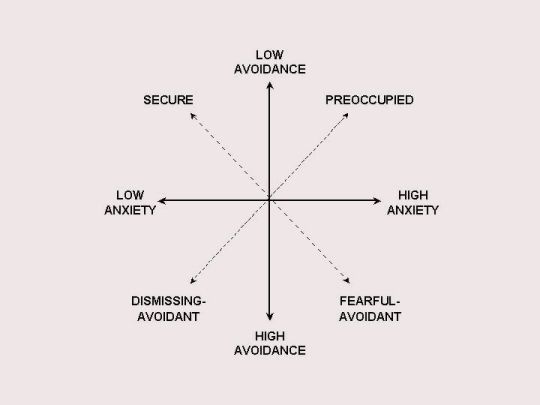Attachment
How to Change Your Attachment Style
Do you feel needy with one person and apathetic with another?
Posted March 18, 2015 Reviewed by Kaja Perina
By Amy Broadway, researcher at the Brogaard Lab for Multisensory Research

Before we dive in, you may want to find where you lie on this chart by taking this quiz.
Does a person have just one attachment style? Can a person’s attachment style change? Why do I feel needy with one person and apathetic with another?
These questions raise issues about the continuity of security in relationships: (1) whether a person’s attachment style is the same in every romantic relationship, and (2) whether a person’s attachment style stays the same through the course of a relationship (Fraley, 2010). Though we may tend toward a style of attachment, styles fluctuate depending on personality changes, partners, and self-regulation.
Before discussing that, let’s note something about categorizing sets of thoughts, emotions, and behaviors. Psychological labels are like signposts, artifacts meant to guide our understanding of how a person generally is and how she may act in the future.
People often don’t fit a label to a tee. While you may exhibit narcissism, commonly linked to an avoidant attachment style, you may express an anxious attachment style instead. Or you may perform most but not all behaviors of an attachment style. This can make naming your attachment style seem elusive.
You can get a decent idea of where you are on a continuum by reviewing how you commonly think, feel, and behave in romantic relationships. Though studies show we don’t know ourselves as well as we think we do, you may observe tell-tale signs that indicate you present a pattern of attachment. If you’re continually afraid your partner will leave you, even when there’s little evidence this will happen, you show anxious style. If you’ve never had a deep relationship even though other people are attracted to you, you could be avoidant.
Let’s consider what attachment style is. Attachment is an emotional bond one develops with another person, which reflects the trust and security she feels in that relationship. Attachment theory is based on the idea that how we bonded with our parents when we were babies impacts our relationships as adults. Why and to what extent a person’s attachment style as an adult mirrors the one developed with early caregivers is not fully understood. Your mother’s neglect may have fostered anxious attachment in you, but additional factors play a role in the security you feel with separate individuals.
Personality changes affect attachment style
While we have basic traits that usually last throughout our lives, how we behave in relationships can change depending on our phase in life. For example, we can feel more or less secure with ourselves in certain phases. When you’re on top of the world (e.g, have a new job, flush, been working out), it’s easier to feel safe in relationships. However, when you’re out of shape, your career is stunted, and your girlfriend starts working with someone particularly hunky, you might experience a flare up of insecure attachment.
As another example, in adolescence, we are less experienced and, yes, driven by raging hormones. Plus, our prefrontal cortex isn’t fully developed. The uncertainty about how relationships will play out can make us insecure. Once we’ve been around the block and know better what’s happening in relationships, we can feel more secure in future relationships, depending on who we’re in relationships with.
Partners affect attachment style
How your partner acts can affect the bond you feel with her. If she pushes you away when you’re feeling anxious, you’ll probably be more anxious. If, on the other hand, she’s able to reassure you, your trust and security may be strengthened.
Unfortunately, sometimes an anxious type can’t be reassured, because he may be anxious to the point of mental illness. But the point is it’s possible to have curative relationships, which teach us to be secure in our attachment even if our parents never did.
Someone who initially has a secure style of attachment can also develop insecure attachment through adult interactions. As Dr. Brogaard points out: “…the nature of friendships and romantic relationships can influence adult attachment in much the same way that early child-caregiver interactions can. Persistent bullying, a cruel partner or a cataclysmic breakup can cause a person with a secure attachment to become insecure, or an anxiously attached person to become avoidant.”
Sometimes a person who is typically an anxious type may be in a relationship with someone and experience no anxiety. This might not be because he’s no longer anxious in relationships but because he is less attached to the person he’s currently with. How much he desires the relationship to continue affects the distress he feels at the possibility it could end. Sometimes we date people we don’t feel bonded to, so what would be our attachment style doesn’t reveal itself, because we’re not in a true attachment relationship.
Self-regulation affects attachment style
Although in childhood you may have learned habits of insecure attachment, it may be possible for you to override them with effort as an adult. Practice being aware of how you interact in relationships to determine what you’d like to improve. Determine what emotions you feel when you experience insecurity with a romantic partner (anxiety, anger, distrust?) and how they diminish your interactions. Learn ways to regulate these emotions through practices such as cognitive-behavioral therapy or mindfulness.
References
Brogaard, Berit. (2015) “Attachment Styles Can’t Change, Can They?” Accessed from https://www.psychologytoday.com/blog/the-mysteries-love/201502/attachme…
Fraley, R. Chris. (2010) “A Brief Overview of Adult Attachment Theory and Research.” Accessed from https://internal.psychology.illinois.edu/~rcfraley/attachment.htm




